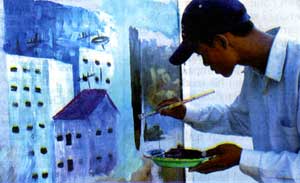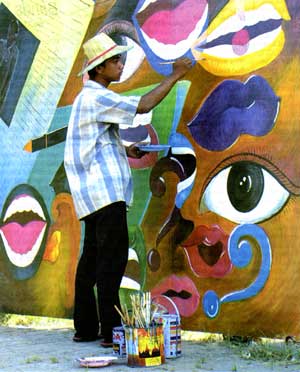|
from the Cambodia Daily, January 3-4, 2004
Picturing What
Democracy Should Be
Art Students
Portray Principles of Freedom
by MICHELLE
VACHON
 |
|
Lang Bunlim, a student of the Reyum Kasumisou Art
School, works on the freedom of speech painting on
the construction walls at the site of the new US
Embassy near Wat Phnom.
|
|
|
 |
|
Pouv Samorn completes the equal rights painting on
the embassy site's wall.
|
|
Democratic
principles can be difficult to put into paintings. Yet this
is the challenge the US Embassy gave the Reyum Kasumisou Art
School in October.
The embassy
called for the school to decorate the temporary walls at the
construction site of its future location across from Wat
Phnom. Since these walls may remain until the new embassy
building is ready to open in 2006, embassy officials decided
to make them useful.
"We thought
this would be a wonderful public space for [Cambodians] to
express their views on what democracy means to them," said
David Gainer, assistant public affairs officer for the US
Embassy.
Three months
ago, the 23 students in the art school's advanced class were
assigned to design 10 paintings illustrating democracy. "At
first, it was difficult to come up with the concepts and
turn them into sketches," said Lim Van Chan, the school
director.
Students
pored over books on democracy to pinpoint major principles.
But at the end of the first week, they only had a couple of
ideas on how to translate those principles into images, said
Lim Van Chan. The following week, they discussed concepts
with the assistance of their teachers, and ended up with 13
themes.
After two
more weeks of drafting and design, they had these themes
painted on small boards, each done in a different style,
ready for embassy officials to review and choose from. "We
felt the paintings were very beautiful and creative—those
students are very talented," said Gainer.
The students
started work on the 10 selected panels on Dec 15, with the
goal of completing them within a month. They paint six days
a week under Lim Van Chan's supervision.
Each panel is
designed as a distinct work of art, individually complete in
style and message.
The painting
on freedom of speech is full of movements and sharp colors,
with mouths talking and ears listening, plus a newspaper in
one corner and a pen in the middle.
The panel
depicting freedom of religion emanates, serenity with its
tones and clear lines. It shows a statue of Buddha, a cross
representing Christianity, a small altar for animism and a
man prostrated toward Mecca— all painted side by side to
express people's right to practice their chosen religion.
The panel on
freedom of assembly is busy with people meeting and reaching
out to one another, painted as oval shapes with arms
stretched toward the next person.
The
democratic right to select one's political leaders through
voting is shown in sober colors and straight shapes, with
one hand putting a check mark on a ballot and another hand
putting it in a ballot-box while people watch.
To express
the concept of equal rights, the students painted a poor
woman smiling and getting a drink from a man in a business
suit, surrounded by well-dressed people in an art gallery.
For the peace
and liberty panel, a young woman in soft tones of green and
blue, her hair and krama floating in the wind, extends her
arms, freeing a dove. The panel on freedom to protect one's
culture and traditions is dominated by the silhouette of
Angkor Wat floating in clouds.
The most
difficult picture to conceive was the one about free market
economy, said Lim Van Chan. In the end, students decided to
use a barcode as back-drop, he said. Barcodes—a series of
black stripes and numbers—appear on all manufactured
products that are imported and exported in a free market
economy.
The most
colorful panel will be the one on children's freedom to play
and study, said Lim Van Chan. It will include bright flowers
and animals to show the joy of children at play, he said.
Finally, the 10th panel will show stylized workers building
the word democracy in Khmer.
The embassy
plans to put up a sign with English and Khmer text
explaining the project, Gainer said.
The Reyum
School offers free art training to street children and to
children of poor families. About 120 students currently
attend the school, Lim Van Chan said.
|